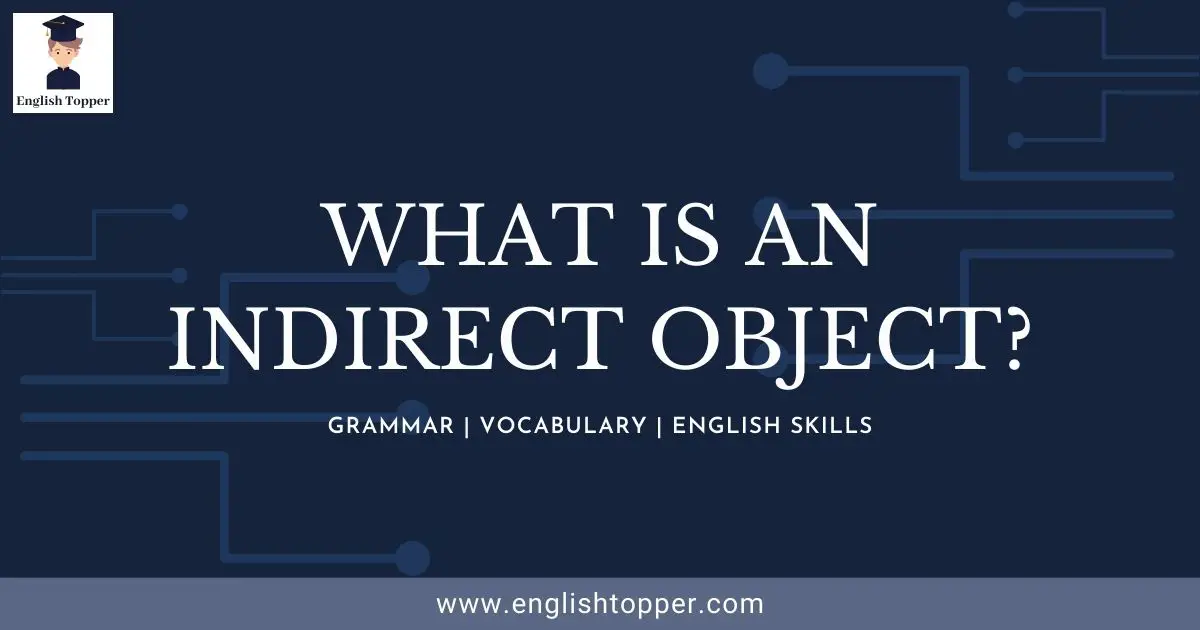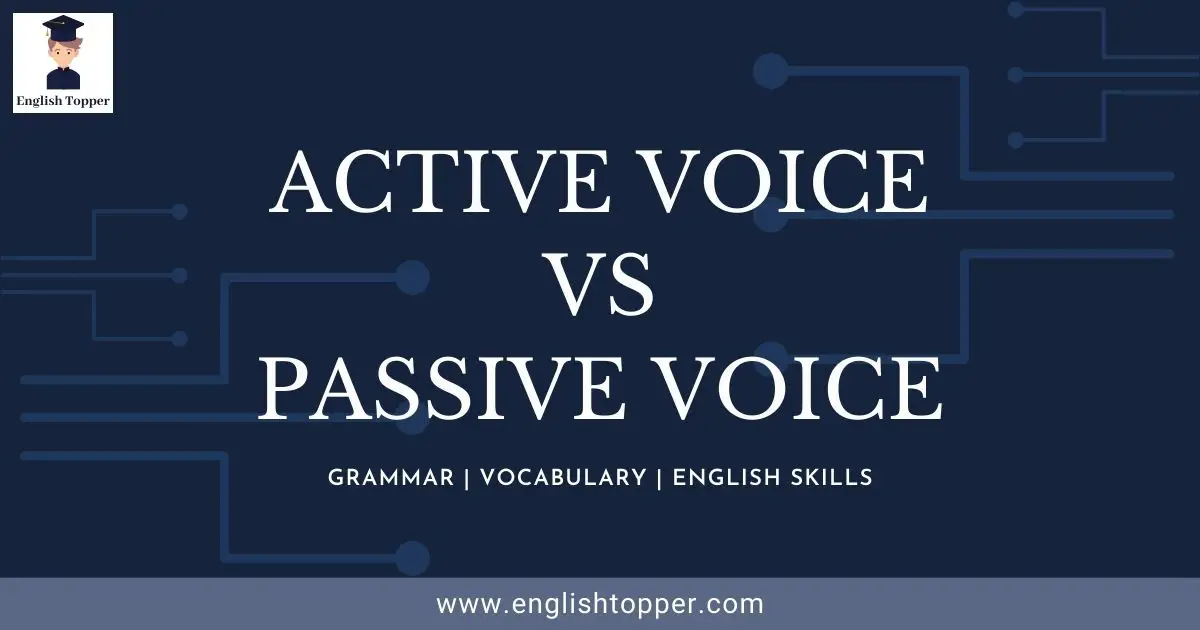|
Getting your Trinity Audio player ready...
|
Table of Contents
What is an Indirect Object?
An Indirect Object is a word or group of words that receive a Direct Object in a sentence. It is located between the Verb and Direct Object.
General Sentence structure according to English Grammar is,
Sentence = Subject + Verb + Object
In terms of Object, the structure is further classified into,
Sentence = Subject + Verb + Indirect Object + Direct Object
=> Sentence = Subject + Verb + “What/Whom” + Direct Object
Here, the action moves from Subject to Verb and then to Direct Object, then moves to Indirect Object.
Let us consider an example sentence,
Raju passed Sunil the ball.
| Subject | Verb | Indirect Object | Direct Object |
| Raju | passed | Sunil | the ball. |
Explanation: The Subject (Raju) made an action which is a Verb (passed) and the action is received by the Direct Object (the ball) and finally received by the Indirect Object (Sunil).
An Indirect Object can also be either,
- a person (or)
- a thing
So, an Indirect Object can function in multiple ways. It can function as,
- Noun
- Pronoun
- Proper Noun
- Noun Phrase
Now let us understand more about these functions with examples.
Different Functions of Indirect Object
Noun as an Indirect Object
Below is an example of how a Noun can be an Indirect Object.
- I wrote a letter to her
Here, I (Subject) wrote (Verb) a letter (Indirect Object) to her (Direct Object) are mentioned. Since “letter” is a name of a thing, so it is a Noun.
What I wrote to her? “A letter” is an Indirect Object.
Also Read: Noun Definition and Examples | (Best English Guide 2021)
Pronoun as an Indirect Object
Below is an example of how a Pronoun can be an Indirect Object.
- John bought him a car.
Here, John (Subject) bought (Verb) her (Indirect Object) a car (Direct Object) are mentioned. Since “her” is a Pronoun.
John bought a car to whom? “him” is an Indirect Object.
Also Read: What is a Pronoun? | Pronoun Definition and Examples (2021)
Proper Noun as an Indirect Object
Below is an example of how a Proper Noun can be an Indirect Object.
- She went to Paris for a holiday trip.
Here, She (Subject) went (Verb) to Paris (Indirect Object) for a holiday trip (Direct Object) are mentioned. Since “Paris” is a Proper Noun.
Where did she went for a holiday trip? “Paris” is an Indirect Object.
Also Read: Proper Noun with examples | Best English Guide 2021
Noun Phrase as an Indirect Object
Below is an example of how a Noun Phrase can be an Indirect Object.
- Sita bought her eldest daughter a house.
Here, Sita (Subject) bought (Verb) her eldest daughter (Indirect Object) a house (Direct Object) are mentioned. Since “her eldest daughter” is a Phrase of a Noun.
Sita bought a house to whom? “her eldest daughter” is an Indirect Object.
More Examples of Indirect Object
Here are some other example sentences of Indirect Objects.
- The teacher appreciated John in the class.
- He joined Army after his education.
- Sunil passed his father a parcel.
- The HR gave the employee a chance.
- Simran gave money to her daughter.
- James travelled London with his wife.
- She read him a letter.
- Jack gifted Mary a toy.
- Harry helped Lisa in finishing her project.
- She made us a pizza.
Using Prepositional Phrase in Indirect Object
Prepositional Phrase is often used for Indirect Object. These are used to rephrase or reposition by adding “for” or “to” before Indirect Object.
For example (compare the below two sentences):
- The teacher gave some projects to the class. (with Prepositional Phrase)
- The teacher gave class some projects.
In the second statement, we can observe that the preposition (to) is excluded, but the meaning is same as the first one.
- Mom made cookies for me. (with Prepositional Phrase)
- Mom made me cookies.
Even though both the sentences are correct and anyone can be used depending on the condition/usage.
Note: The Prepositional Phrase is not an Indirect Object.
Basic Rules of Indirect Object
Here are some rules that you need to follow if you are using Indirect Object in a sentence.
Rule 1: Indirect Object always needs Direct Object.
Indirect Object cannot be used without having Direct Object, because Direct Object is an important part of the sentence which usually describes about the action received from the Subject.
Indirect Object is an extension of the Direct Object which is used to receive the action from the Direct Object.
So, before you use Indirect Object in a sentence, make sure you have Direct Object in it.
Rule 2: When Indirect Object is a Pronoun, then it must be an Objective Case.
When Pronoun is used as an Indirect Object in a sentence, then must be an Objective Case. It can also have Subjective Case.
Below table shows various Subjective and Objective cases that you can refer.
| Subjective Case | Objective Case |
| he | him |
| she | her |
| it | it |
| I | me |
| you | you |
| we | us |
| they | them |
Let us understand this with few examples.
- Incorrect (X): The manager gave they the bonus money.
- Correct (_/): The manager gave them the bonus money.
- Incorrect (X): Did he gave she the money?
- Correct (_/): Did he gave her the money?
Rule 3: Only Transitive Verbs can be used for Indirect Object.
The only verbs that can be used for Indirect Object is Transitive Verbs. These verbs are also used for Direct Object as well.
So, overall Transitive verbs are used for both Direct and Indirect Objects in a sentence. Non transitive verbs should not be used.
Example (with Transitive Verb):
- Sita bought him a car.
| Subject | Transitive Verb | Indirect Object | Direct Object |
| Sita | bought | him | a car. |
Note: The blue coloured word in the above example is a Transitive Verb.
Example (with Intransitive Verb):
- The cars raced down the street.
Here the verb (raced) does not answer “what?” or “whom?”. So, it can’t be used for Indirect Object (as well as for Direct Object also).
Note: The blue coloured word in the above example is a Intransitive Verb.
How to identify an Indirect Object in a sentence?
To identify an Indirect Object in a sentence, you need to follow step by step procedure and it is easy to find out.
Let us consider an example on how to find it.
Example: Raju passed Sunil the ball.
Step 1: First, find out the Subject in the given sentence. (Subject: Raju)
Step 2: Next, find out the verb in the given sentence. Make sure that it is a Transitive Verb but not Intransitive. (Verb: passed)
Step 3: Then, find the Direct Object in the sentence. Remeber that Direct Object is the receiver of the action of the Subject. (Direct Object: ball)
Step 4: Finally, find out the Indirect Object by considering “for/to whom/what” in the sentence. (Indirect Object: Sunil).
Ex: Raju passed the ball to whom? “Sunil” is an Indirect Object.
Summary: (What is an Indirect Object?)

Here is the summary of what we have learnt till now.
- Indirect Object is a type of Object is effected indirectly by the action of the verb.
- An Indirect Object can be Noun, Pronoun, Noun Phrase and Proper Noun.
- Only Transitive Verbs are used for Indirect Objects.
- Indirect Object can only be used only when Direct Object is used.
- When Indirect Object is a Pronoun, then it must be an Objective Case.
If you are interested to learn more, then you can refer to Wikipedia here.
I hope that you understood the topic “What is an Indirect Object?”. If you still have any doubts, then comment down below and we will respond as soon as possible. Thank You.





